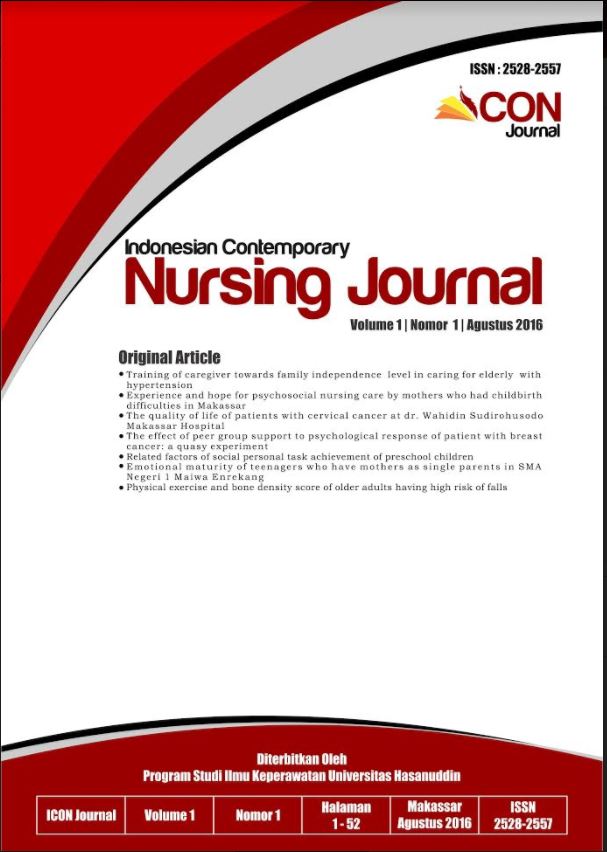Experience and Hope for Psychosocial Nursing Care by Mothers Who Had Childbirth Difficulties in Makassar
DOI:
https://doi.org/10.20956/icon.v1i1.3269Abstract
Introduction: Women in difficulty delivery process need a psychosocial nursing care in order to reduce their stress that in turn will affect the delivery process. The aim of this study is to identify the experience and expectation of psychosocial nursing care in women who have experienced childbirth difficulties in Makassar.
Method: This research used qualitative research method. Seven women who participated in this research are selected by purposive sampling. Data are analyzed using Collaizi method.
Result: Result are grouped into physical and psychological complaints during childbirth difficulties, effort to overcome complaint, family responses during childbirth difficulties, experience and perception of physical and psychosocial nursing care during childbirth difficulties, and expectation of psychosocial nursing care during childbirth difficulties. Conclusion: Variation of psychosocial nursing care is needed, in order to minimize the impact of childbirth difficulties.References
Adams, E.D. & Bianchi, A.L.(2008). A Practical approach to labor support. Journal of Obstetric, Gynecology and Neonatal Nursing, 37 pg 106-115. Diperoleh 2 juli 2010
Callister, L.C. & Khalaf, I. (2010). Spirituality in childbearing women. The Journal of Perinatal Education, 19 (2) pg 16-24. Diperoleh 25 Juni 2010
Corbett, C.A. & Callister, L.C. (2000), Nursing support during childbirth. Clinical Nursing Research, 9 (1) pg 70-83. Diperoleh 10 Desember 2009
D'Ambruoso, L. Abbey, M. & Hussein, J. (2005). Please understand when I cry out in pain: Women's accounts of maternity services during labour and delivery in Ghana. BMC Public Health, 5 (140) pg 1-9 Diperoleh 5 Juli 2010
McCallum, C. & dos Reis, A.P. (2005).Childbirth as Ritual in Brazil: Young Mothers’ Experiences. Ethnos. 70 (3) pg 335–360. Diperoleh 6 juli 2010
Meyer, B.A. Arnold, J.A. & Pascali-Bonaro, D. (2001). Social support by doulas during labor and the early postpartum period. Hospital Physician, 57-65. Diperoleh 20 Juni 2010
Nystedt, A. Hogberg, U. & Lundman, B. (2004). The negative birth experience of prolonged labour: a case–referent study. Journal of Clinical Nursing, 14, 579-586. Diperoleh 20 Juni 2010
Nystedt, A. Hogberg, U. & Lundman, B. (2006). Some Swedish women's experiences of prolonged labor. J Midwifery, 22 (1), 56-65. Diperoleh 8 Pebruari 2010
Sambas, E.K. (2005). Pengaruh perilaku suportif perawat dan bidan terhadap intensitas nyeri persalinan pada ibu intra partum kala satu di RS Hasan Sadikin dan RS Cibabat Bandung. Tesis. Depok: Fakultas Ilmu Keperawatan Universitas Indonesia (tidak dipublikasikan)
Saragi, M.M. (2009). Respon dan koping ibu bersalin yang mengalami persalinan lama di Badan Rumah Sakit Daerah Cibinong: Studi grounded theory. Tesis. Depok: Fakultas Ilmu Keperawatan Universitas Indonesia (tidak dipublikasikan)
Sauls, D.J. (2004). Adolescents' perception of support during labor. The Journal of Perinatal Education, 13 (4), 36-42
Sauls, D.J. (2006). Dimensions of professional labor support for intra partum practice. Journal of Nursing Scholarship, 38 (1),36-41. Diperoleh 20 Juni 2010
Souza, J.P. Cecatti, J.G. Parpinelli, M.A. Krupa, F. & Osis, M.J.D. (2009). an Emerging “Maternal Near-Miss Syndrome”: Narratives of women who almost died during pregnancy and childbirth, BIRTH Journal., 36, 149-158.
Suarni, L. (2004). Persepsi ibu tentang dukungan psikososial yang diharapkan pada masa childbearing di desa Candimas Lampung Utara. Tesis. Depok: Fakultas Ilmu Keperawatan Universitas Indonesia (tidak dipublikasikan)
Tumblin, B.A. & Simkin, P.T. (2001). Pregnant Women’s Perceptions of Their Nurse’s Role During Labor and Delivery. BIRTH Journal, 28 (1), 52-56. Diperoleh 6 Juli 2010
Downloads
Published
How to Cite
Issue
Section
License
Authors who publish with this journal agree to the following terms:Authors retain copyright and grant the journal right of first publication with the work simultaneously licensed under a Creative Commons Attribution License that allows others to share the work with an acknowledgement of the work's authorship and initial publication in this journal.
Authors are able to enter into separate, additional contractual arrangements for the non-exclusive distribution of the journal's published version of the work (e.g., post it to an institutional repository or publish it in a book), with an acknowledgement of its initial publication in this journal.
Authors are permitted and encouraged to post their work online (e.g., in institutional repositories or on their website) prior to and during the submission process, as it can lead to productive exchanges, as well as earlier and greater citation of published work (See The Effect of Open Access).



